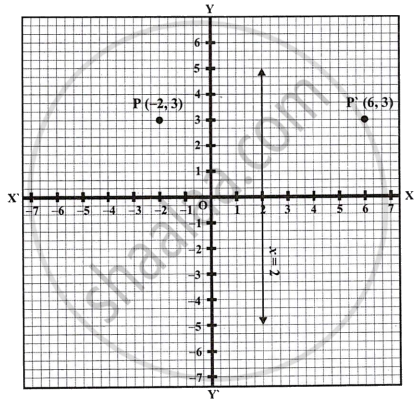Advertisements
Advertisements
Question
A point P (–2, 3) is reflected in line x = 2 to point P’. Find the co-ordinates of P’.
Solution

The image of P (–2, 3) is P' which is reflected in the line x = 2.
The co-ordinates of P' will be (6, 3) as shown in the graph.
APPEARS IN
RELATED QUESTIONS
Points (3, 0) and (–1, 0) are invariant points under reflection in the line L1; points (0, –3) and (0, 1) are invariant points on reflection in line L2.
- Name or write equations for the lines L1 and L2.
- Write down the images of the points P (3, 4) and Q (–5, –2) on reflection in line L1. Name the images as P’ and Q’ respectively.
- Write down the images of P and Q on reflection in L2. Name the images as P” and Q” respectively.
- State or describe a single transformation that maps P’ onto P''.
The points P (4, 1) and Q (–2, 4) are reflected in line y = 3. Find the co-ordinates of P’, the image of P and Q’, the image of Q.
A point P (a, b) is reflected in the x-axis to P’ (2, –3). Write down the values of a and b. P” is the image of P, reflected in the y-axis. Write down the co-ordinates of P”. Find the co-ordinates of P”’, when P is reflected in the line, parallel to y-axis, such that x = 4.
- Plot the points A (3, 5) and B (–2, –4). Use 1 cm = 1 unit on both the axes.
- A’ is the image of A when reflected in the x-axis. Write down the co-ordinates of A’ and plot it on the graph paper.
- B’ is the image of B when reflected in the y-axis, followed by reflection in the origin. Write down the co-ordinates of B’ and plot it on the graph paper.
- Write down the geometrical name of the figure AA’BB’.
- Name the invariant points under reflection in the x-axis.
The point P (3, 4) is reflected to P’ in the x-axis; and O’ is the image of O (the origin) when reflected in the line PP’. Write:
- the co-ordinates of P’ and O’.
- the length of the segments PP’ and OO’.
- the perimeter of the quadrilateral POP’O’.
- the geometrical name of the figure POP’O’.
A (1, 1), B (5, 1), C (4, 2) and D (2, 2) are vertices of a quadrilateral. Name the quadrilateral ABCD. A, B, C, and D are reflected in the origin on to A’, B’, C’ and D’ respectively. Locate A’, B’, C’ and D’ on the graph sheet and write their co-ordinates. Are D, A, A’ and D’ collinear?
P and Q have co-ordinates (0, 5) and (–2, 4).
- P is invariant when reflected in an axis. Name the axis.
- Find the image of Q on reflection in the axis found in (a).
- (0, k) on reflection in the origin is invariant. Write the value of k.
- Write the co-ordinates of the image of Q, obtained by reflecting it in the origin followed by reflection in x-axis.
A’ and B’ are images of A (-3, 5) and B (-5, 3) respectively on reflection in y-axis. Find: (
a) the co-ordinates of A’ and B’.
(b) Assign special name of quadrilateral AA’B’B.
(c) Are AB’ and BA’ equal in length?
Use a graph paper for this question.
(Take 2 cm = 1 unit on both x and y axes)
- Plot the following points: A(0, 4), B(2, 3), C(1, 1) and D(2, 0).
- Reflect points B, C, D on the y-axis and write down their coordinates. Name the images as B', C', D' respectively.
- Join the points A, B, C, D, D', C', B' and A in order, so as to form a closed figure. Write down the equation to the line about which if this closed figure obtained is folded, the two parts of the figure exactly coincide.
Points (3, 0) and (-1, 0) are invarient points under reflection in the line L1; point (0, -3) and (0, 1) are invarient points on reflection in line L2.
(i) Write the equation of the line L1 and L2.
(ii) Write down the images of points P(3, 4) and Q(-5, -2) on reflection in L1. Name the images as P' and Q' respectively.
(iii) Write down the images of P and Q on reflection in L2. Name the image as P'' and Q'' respectively.
